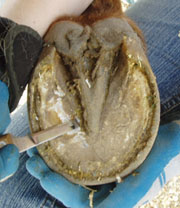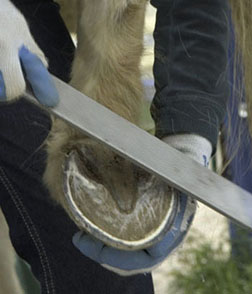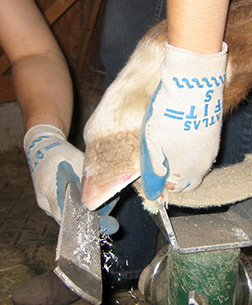










|
The Trim Each horse and each hoof is different, but in a typical trim I will: -- Observe the hoof and take note of angle of growth, flares, imbalances, cracks, etc. The finished hoof should be balanced and symmetrical, and the exterior hoof, walls and sole, should fit evenly around the internal structures of the hoof. Transition and Hoof Boots: Most horses make the transition to barefoot without any problem, although some do need a healing period during which time the use of hoof boots while riding is recommended until their hooves toughen up. Today’s hoof boots offer protection when needed while still allowing circulation, proper shock absorption and sensation, whereas shoes preclude all these natural functions and are affixed to the foot at all times. I also appreciate your letting me know how your horse is doing, especially during the first few months of barefoot, so that I can tailor my approach to his individual needs.
"Every hoof, in accordance with the horse’s overall conformation, has its own unique signature of active and passive wear. Indeed, “hoof balance:” is in large measure defined by the salience of the active points, in other words, how the hoof is “propped up” upon them. Horseshoesg, it is worth reflecting on, obliterates this signature by the need to level the hoof wall in order to stabilize the shoe when it is nailed on. Natural hoof care practitioners, in contrast, trim the hoof wall to facilitate the natural convolutions of the hoof wall—its signature, in other words…" |
|


